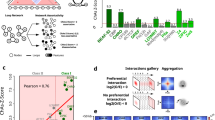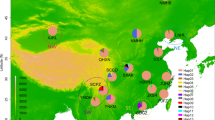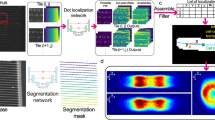ABSTRACT
Drosophila lacertosa is widely distributed from northern India to Far East of Russia throughout China. We have studied geographical distributions of three kinds of chromosomal karyotypes, type D (2n=10, 4 pairs of V-shaped metacentric chromosomes and a pair of micro-chromosomes), type L (2n=10, 5V with a pair of large-sized heterochromatic autosomes) and type M (2n=10, 5V with middle-sized ones). Type D was found exclusively in local populations of D. lacertosa distributed in Yun-Gui Plateau, southwestern China. Both type L and M have a wide range of distribution, and the former occurred in subtropical regions of China including Taiwan Island, whereas the latter in cool temperate regions of East Asia covering Far East of Russia, Korea and the Japan Islands. A strong premating isolation was detected between flies with type D and those with type L or M. These data demonstrate that genetic differentiation leading to cryptic speciation might have occurred in natural populations of Drosophila lacertosa.
Similar content being viewed by others
Log in or create a free account to read this content
Gain free access to this article, as well as selected content from this journal and more on nature.com
or
References
White MJD . Modes of speciation. W. H. Freeman Press: San Francisco. 1978.
Patterson JT, Stone WS . Evolution in the genus Drosophila. New York, Macmillan Co. 1952.
Miller DD, Stone LE . Reinvestigation of karyotype in Drosophila affinis Sturtevant and related species. J Hered 1962; 53:12–24.
Wilson FD, Wheeler MR, Harget M, Kambysellis M . Cytogenetic relations in the Drosophila nasuta subgroup of the immigrans group of species. Univ Tex Publs 1969; 6918:207–53.
Baimai V . Karyotype variation in Drosophila birchii Chromosoma 1969; 27:381–94.
Baimai V, Chumchong C . Karyotype variation and geographic distribution of the three sibling species of the Drosophila Kikkawai complex. Genetica 1980; 54:113–20.
Baimai V, Trapakvasin A, Kitagawa O . Additional data on metaphase karayotype variation and graphic distribution of the Drosophila kikkawai complex. Jpn J Genet 1986; 61:207–16.
Ling FY, Wang W . A new karyotype of Drosophila albomicans. Acta Genetica Sinica 1997; 24:496–500.
Baimai V . Population cytogenetics of the malaria vector Anopheles leucosphyrus group. Southeast Asian J Trop Med Pub Hlth 1988; 19:668–80.
Baimai V . Heterochromatin accumulation and karyotypic evolution in some Dipteran insects. Zoological Studies 1998; 37:75–88.
Gupta JP, Sundaran AK . Some evidence of incipient speciation in Drosophila kikkawai. Genome 1994; 37:1041–4.
Lambert DM . Cytogenetic Evidence of a Possible Fourth Cryptic Species Within the Taxon Anopheles marshallii (Theobald) (Diptera: Culicidae) from Northern Natal. Mosquito Systematics 1981; 13:168–75.
Subbarao SK, Vasantha K, Adak T, Sharma VP . Anopheles culicifacies complex: evidence for a new sibling species, species C. Ann Entomol Soc Amer 1983; 76:985–8.
Levitan N . The robusta and melanica groups. In: Ashburner M, Carson HL, Thompson JN, Eds. The genetics and biology of Drosophila, Vol 3b. Academic Press: London; 1982:141–92.
Narayanan Y . The phylogenetic relationships of the members of the Drosophila robusta group. Genetics 1973; 73:319–50.
Ling FY, Zhang WX . Studies on the karyotypes of some Chinese Drosophilid flies. Zoological Research 1987; 8:410–12.
Watabe H, Park J, Aotsuka T . A karyotype study of the Drosophila robusta species-group (Diptera:Drosophilidae). Zoological science 1997; 14:855–8.
Mayr E . Populations, Species, and Evolution. Harvard University Press: New York, 1974.
Powell JR . Process and prospects in evolutionary biology. The Drosophila model. Oxford university press: New York and Oxford 1997; 306.
Papaceit M, Juan E . Fate of dot chromosome genes in Drosophila willistoni and Scaptodrosophila lebanonensis determined by in situ hybridization. Zoological Studies Chromosome Res 1998; 6:49–54.
White MJD . Animal cytology and evolution, 3rd ed. Cambridge University Press: London 1973:334–405.
Watabe H, Nakata S . A comparative study of genitalia of the Drosophila roubsta and D. melanica species-group (Dipetera: Drosophilidae). J Hokkaido Univ of Education Ser. IIB. 1989; 40:1–18.
He LP, Watabe H, Liang XC, Zhang YP, Aotsuka T . Genetic differentiation and cryptic speciation in Drosophila lacertosa (in preparation).
Walker TJ . Cryptic species among sound-producing ensiferan Orthoptera (Gryllidae and Tettigoniidae). Quart Rev Biol 1964; 39:345–55.
Acknowledgements
We are grateful to Dr. MJ Toda (Hokkaido University), Dr. QT Zeng (Hubei University), Dr. HW Chen (Tokyo Metropolitan University, TMU), Dr. JJ Gao (Kunming Institute of Zoology, KIZ), Mr. BC Wang (KIZ), Dr. JG Xiang-Yu (KIZ), Miss. C Tanaka (TMU), Mr. S Saito (TMU), Mr. A Nozawa (TMU) and Mr. H Ito (Hokkaido University of Education) for their help in field collection and stocks. We also thank Dr. XZ. Zheng (University of Pennsylvania Medical School) and Dr. XC Liang (KIZ) for invaluable discussion on the earlier version of the manuscript. The present work was supported by National Natural Science Foudation of China, (No. 39930100, 30024004), Chinese Academy of Science (No. KSCX2- 1-05) and Japan Society for the Promotion of Science (No. 12375002)
Author information
Authors and Affiliations
Corresponding authors
Rights and permissions
About this article
Cite this article
HE, L., WATABE, H., ZHANG, Y. et al. Karyotype differentiation and reproductive isolation among natural populations of Drosophila lacertosa. Cell Res 13, 491–497 (2003). https://doi.org/10.1038/sj.cr.7290192
Received:
Revised:
Accepted:
Issue date:
DOI: https://doi.org/10.1038/sj.cr.7290192
Keywords
This article is cited by
-
Independent Origins of New Sex-Linked Chromosomes in the melanica and robusta Species Groups of Drosophila
BMC Evolutionary Biology (2008)



